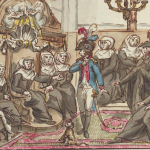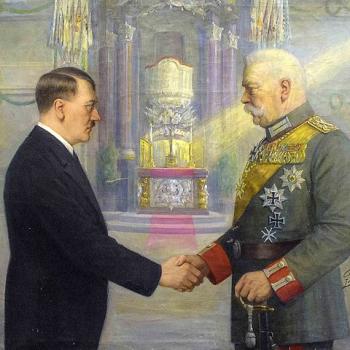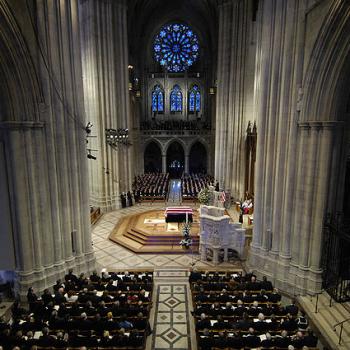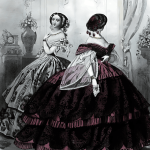Christian mysticism flourished in 13th century Europe. Many of the 13th century mystics were Beguines, whom I wrote about in the last post. Beguines were laywomen who wore habits and lived lives dedicated to charity, chastity, austerity, and piety. But they did so without joining the formal nuns’ orders. This gave them a bit more independence from the patriarchal Church than they would have had as nuns.
Many of these mystics are identified today as part of a particular school of mysticism, called “Rhineland mysticism” or “Rheno-Flemish mysticism” because it developed in Flemish-speaking Belgium and the Rhineland. These mystics primarily are known for seeking God within rather than without. In this they differed from the 12th century mystic Hildegard of Bingen (1098-1179), who experienced visions she believed were coming to her from a divine source outside herself.
And note that this post is a mere brief introduction to a vast subject.
The Spiritual Path of Love
The Beguine mystics also wrote a great deal about love, in its many forms, as an essential part of their spiritual path. In her book Women Mystics in Medieval Europe (Paragon House, 1998), Emilie Zum Brunn wrote,
In the writings of our Beguines the symbolism of courtly love mingles wth the metaphysical expression of union with God, thanks to their profane as well as religious culture. … In fact, the great development of nuptial mysticism in the West goes back to St. Bernard’s Sermons on the Song of Songs, in which he applies the eroticism of the sacred text to the relation between the soul and the Divine Word.
And it occurs to me that these 13th century women had an older sister they probably never heard of — the Sufi mystic Rābiʿah al-ʿAdawīyah (713/17–801), whose path in Islam also was guided by love.
Brunn continues, explaining that along with the mysticism of love, the Beguines also explored “the mysticism of Being.” This includes the Divine Being as well as their own being. “This integration of our relations with God within the Trinitarian relationship ‘so that God loves Himself by and in the very human heart,’ will also become a characteristic of Beguine spirituality,” Brunn writes, quoting William of Saint-Thierry (1085-1148).
However, by the beginning of the 14th century many of them were facing condemnation by the Pope and even execution by the Inquisition.
What Is Mysticism?
Mysticism is a word that causes a huge amount of controversy and confusion. It comes from the same root word as mystery, referring to things that are hidden or secret. A huge number of practices and beliefs get lumped under the heading of mysticism, including occult practices like seances and consulting Ouija boards. Anything called “mystical” is often dismissed out of hand as superstitious flimflam, and often it is. But, perhaps, sometimes it isn’t.
The Oxford dictionary has two definitions of mysticism. One describes delusional and dreamy ideas based on superstitious beliefs. The other is the “belief that union with or absorption into the Deity or the absolute, or the spiritual apprehension of knowledge inaccessible to the intellect, may be attained through contemplation and self-surrender.” Knowledge or understanding inaccessible to the intellect is a critical point here, as well as self-surrender. The mystical traditions of the major religions — and they all have mystical traditions — describe understanding of God or the absolute ground of being achieved through direct and intimate experience rather than by rational thought or acceptance of doctrine.
The medieval work The Sister Catherine Treatise tells the story of a nun who has achieved deep spiritual union with God. She tries to explain her insight to her confessor, a priest whose understanding is entirely conceptual and intellectual. The point of the work is that the nun’s understanding is greater than the priest’s. The mystical path takes one beyond conceptual understanding to something, well, different. But it’s not necessarily superstitious flimflam. Emilie Zum Brunn wrote of the difference between “a doctrine that remains fettered to the level of intellect and one that is applied to life itself. This latter doctrine allows one to rise to a higher kind of knowledge, not merely theoretical but constitutive of being.”
A Few Beguine Mystics
There were many Beguine mystics. Here are three especially prominent ones.
Mechthild of Magdeburg (c. 1210–c. 1290) is one of the best remembered of the Beguine mystics. Her book The Flowing Light of the Godhead (Das fließende Licht der Gottheit), written in German over a period of many years, is a collection of poetry, autobiography, and accounts of her mystical experiences. She was the first of the mystics to write and publish in a language other than Latin, which deeply offended the Catholic Church of the time. Many also were offended at the presumption of spiritual insight by an unordained woman. Further, she criticized the decadence of the clergy, which may have been her greatest offense to the clerical establlishment. After many years as a Beguine she moved into a Cistercian convent, which offered her protection during the last years of her life. It’s not clear whether she formally became a nun or lived with the nuns as a laywoman.
We know that Hadewijch of Antwerp lived in the 13th century, although the dates of her birth and death are unknown. Her work was forgotten for many years and then rediscovered in the 19th century. Apparently what she wrote created so much antagonism she left her community of Beguines so as not to endanger them. As with many other Beguine mystics Hadewijch wrote a great deal about love, in its many forms. In her allegorical narratives Love is a queen of great power and riches. Love is also a force that leads Hadewijch on her spiritual journey, which was not an easy one. Through love, we “become God with God,” she wrote.
I have already written about Marguerite Porete, who was burned at the stake by the Inqusition in 1310. Her book The Mirror of Simple Souls describes the eventual perfection of the soul by means of love. In that perfection individual identity and will are completely forgotten in union with God.
Other 13th (and 14th) Century Mystics
Beatrice of Nazareth (c. 1200–1268) was educated by Beguines as a young girl but became a Cistercian nun when she was about sixteen years old. (The Nazareth in her name a town in Belgium.) She is remembered for her brief work The Seven Manners of Love. Like Hadewijch of Antwerp, Beatrice described love as a force that shapes the spiritual path, and in Seven Manners she describes seven ways that love challenges and guides us. She was not a Beguine but seems to have been on the same page with her Beguine sisters. The Cistercian monastic order was very much influenced by the previously mentioned St. Bernard (1090–1153), and there seems to have been a deep affinity between the Beguines and the Cistercians in the 13th century.
Meister Eckhart (c. 1260– c. 1328) is today one of the most celebrated of the medieval Christian mystics. Like the Beguines, Eckhart was focused on the mystery of being and the union of the soul with God. “The eye with which I see God is the same eye with which God sees me,” he said. In recent decades a number of scholars have proposed that Eckhart was very much influenced by the Beguines. Like the unfortunate Marguerite Porete, Eckhart was accused of heresy by the Inquisition. He escaped execution by dying of other, unknown, causes before his verdict was delivered.
John van Ruysbroeck (1293 or 1294–1381) was another prominent Flemish mystic. Ruysbroeck was clearly influenced by the Beguine mystics, especially Mechthild of Magdeburg. In one of his books, The Twelve Beguines, he presents his insights by means of an imagined conversation among a group of Beguines.














